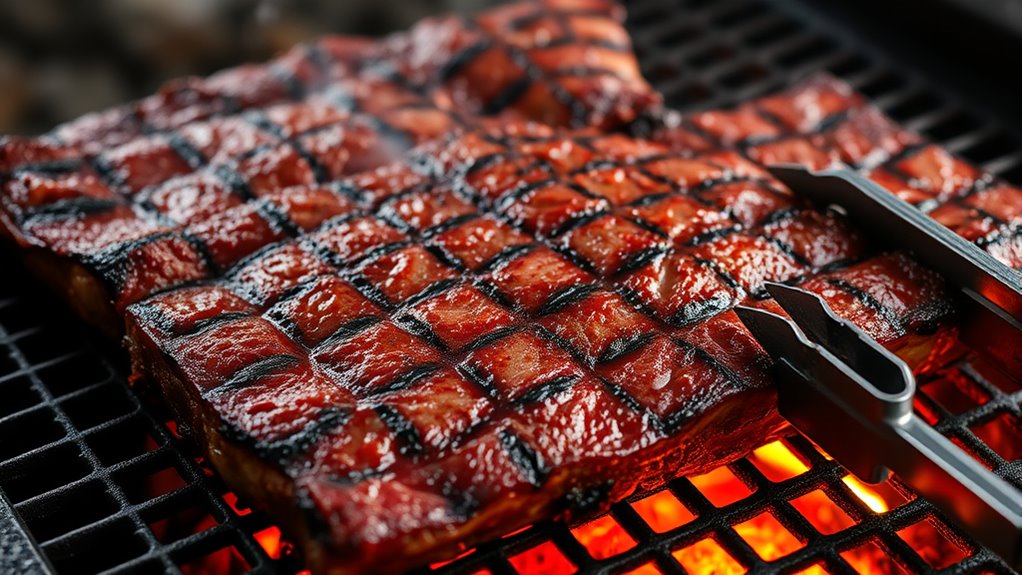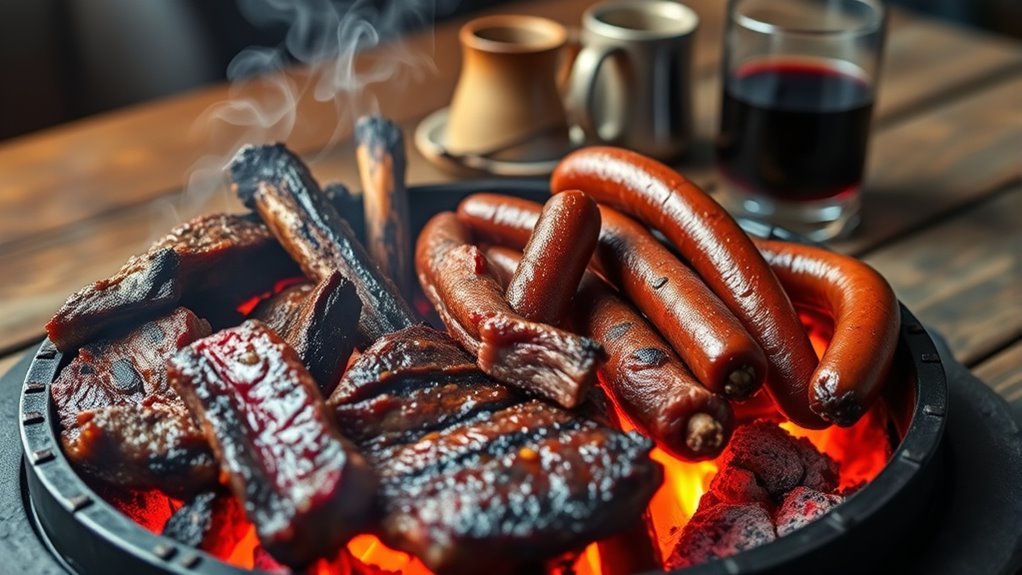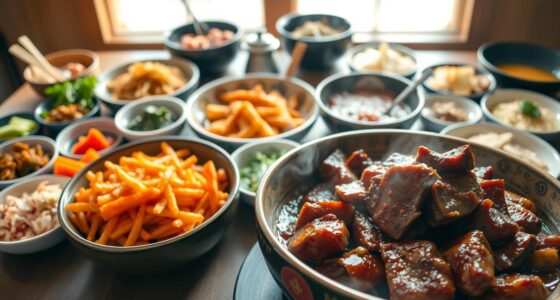To master Argentine asado, select cuts like asado de tira, vacio, or entraña, focusing on marbling and quality. Build a proper grill from bricks or metal and manage the fire with hardwood coals like quebracho or oak for consistent heat and flavor. Control the temperature by adjusting airflow and distance from the coals. Use direct heat for quick-cooking cuts and slow heat for tougher meats. Keep exploring for detailed techniques and seasoning tips to perfect your asado.
Key Takeaways
- Use hardwood like quebracho or oak for consistent heat and rich flavor during grilling.
- Arrange coals in a pyramid shape for optimal airflow and even embers for uniform cooking.
- Select high-quality cuts such as asado de tira, vacio, and entraña, considering fat content for flavor and tenderness.
- Control temperature by adjusting airflow vents and the distance between coals and the grill grate.
- Incorporate traditional marinades and chimichurri to enhance flavor and tenderness of the meat.
The Traditional Argentine Asado Setup

The traditional Argentine asado setup centers around a carefully arranged parrilla, or grill, built from bricks or metal. You’ll want to position the parrilla in a well-ventilated outdoor space, often on a sturdy foundation. The grill itself is designed to hold the embers and control airflow, which is vital for cooking the meat evenly. You might include a simple ash catcher or a metal shelf underneath for tools and charcoal storage. The setup typically features a side table or surface nearby to prepare and season the meat. You’ll also need a good supply of firewood or charcoal, as the quality of the fire influences the flavor. With this setup, you’re ready to start your asado, focusing on proper heat and airflow management. Incorporating fire management techniques can help ensure consistent cooking temperatures and optimal flavor. Additionally, maintaining a steady temperature allows for slow cooking that enhances tenderness and flavor. A well-designed setup also considers safety precautions, ensuring safe handling of fire and hot surfaces throughout the cooking process.
Choosing the Right Cuts of Beef

When selecting beef for your asado, you’ll want to consider popular cuts like ribs and flank that are favorites in Argentina. Think about the fat content, as some cuts offer rich flavor with more marbling, while leaner options provide a different taste experience. Choosing the right cuts guarantees your asado will be flavorful and perfectly suited to your preference. Additionally, understanding net worth growth hacks can inspire you to invest in quality meat and tools that enhance your grilling experience. Paying attention to AI security vulnerabilities can also help you stay informed about safety considerations related to modern technology in food sourcing and preparation. Exploring grill accessories can further elevate your asado by ensuring you have the appropriate equipment for optimal results. Selecting cuts with the ideal sugar content can also influence flavor and tenderness, especially if you plan to incorporate marinades or glazes. Furthermore, opting for unique and wicked planters can inspire creative presentation and serving styles for your grilled dishes.
Popular Argentine Cuts
Choosing the right cuts of beef is essential for a perfect Argentine asado, and knowing which parts are most prized makes all the difference. Argentine chefs favor cuts that offer tenderness and rich flavor, often cooked simply to highlight their qualities. Some of the most popular cuts include:
- Asado de Tira (short ribs), perfect for slow grilling
- Vacio (flank steak), known for its juiciness and marbling
- Matambre (thin flank), great for grilling or stuffing
- Entrana (skirt steak), prized for its intense beef flavor
- Bife de Chorizo (sirloin steak), a classic choice for grilling perfection
Focusing on these cuts ensures your asado delivers authentic taste and texture that define Argentine grilling. Proper preparation and understanding of meat quality can further enhance your grilling success. Additionally, selecting cuts with good marbling can help ensure juiciness and flavor during cooking.
Fat Content and Flavor
Selecting cuts with the right fat content is key to achieving the rich flavor and tender texture that characterize an authentic Argentine asado. Well-marbled cuts, like ribeye or entrecôte, have enough fat to baste the meat during grilling, enhancing juiciness and flavor. Leaner cuts, such as sirloin or round, can be tasty but may require careful cooking to avoid dryness. Fat acts as a flavor carrier, adding richness and depth to each bite. When choosing your meat, consider how much fat you prefer—more fat means more flavor but also more drippings. Vibrational energy surrounding the meat can influence its flavor profile, so maintaining positive intentions can enhance your grilling experience. Balance is essential; select cuts that suit your taste and cooking method to ensure your asado is both flavorful and tender. Proper fat content elevates the entire grilling experience.
Preparing the Grill and Fire

To start your Argentine asado, you need a properly prepared grill and a well-established fire. First, choose the right charcoal or wood—preferably hardwood like quebracho or oak for consistent heat and flavor. Arrange the coals or wood in a mound or pyramid to promote good airflow. Light the fire early, allowing it to burn down until you get a bed of glowing embers. Spread the embers evenly to ensure uniform cooking. Keep a supply of additional wood or charcoal nearby for maintaining heat. Control the temperature by adjusting the distance between the coals and the grill grate. Remember, patience is key—wait until the fire reaches the right temperature control before placing your meat. This foundation guarantees a flavorful, perfectly cooked asado. Regularly monitoring the fire management helps maintain consistent heat throughout the cooking process. Utilizing hybrid techniques can also help optimize heat distribution and cooking efficiency during your asado. Proper airflow is essential for controlling the fire’s intensity and ensuring even cooking. Additionally, understanding how to regulate pressure and airflow in your fire setup can lead to better temperature control and more consistent results.
Techniques for Perfectly Grilled Meat

Mastering the art of grilling involves more than just placing meat on the fire; it requires attention to timing, heat, and technique. First, control your heat source, using high heat for searing and lower heat for cooking through without burning. Keep the lid closed to maintain consistent temperature and avoid flipping the meat too often—wait until you see a good sear before turning. Use tongs instead of a fork to prevent losing juices. For thicker cuts, start with high heat to develop a crust, then finish with indirect heat. Always rest the meat for a few minutes after grilling to let juices redistribute. Proper heat management, such as using high refresh rates, is crucial for even cooking and optimal results. Additionally, understanding heat control techniques can help you achieve the perfect doneness every time. Paying attention to temperature monitoring ensures your meat is cooked to your desired level of doneness. Incorporating a thermometer can aid in precise temperature measurement and enhance your grilling success. Being aware of meat cuts and their specific cooking needs can further improve your asado results. By paying close attention to these techniques, you’ll achieve perfectly grilled meat every time, with a flavorful crust and tender interior.
The Art of Asado Chimichurri and Marinades

The true flavor of Argentine asado often comes from the vibrant and aromatic chimichurri, a traditional herb sauce that complements grilled meats perfectly. To craft a great chimichurri, you’ll want fresh parsley, garlic, red pepper flakes, oregano, and olive oil. You can customize it by adjusting the herbs or adding a splash of vinegar for acidity. Marinades are just as important; they tenderize and infuse flavor into your meat. Keep in mind:
- Use a good quality olive oil for richness
- Balance acidity with vinegar or lemon juice
- Incorporate herbs like oregano or thyme
- Add crushed garlic for depth
- Let the meat marinate for at least an hour
- Incorporating essential oils in your marinades can elevate the flavor profile and add aromatic depth. Additionally, understanding how automation in business enhances efficiency can inspire innovative techniques in your grilling process.
Mastering these elements elevates your asado, making every bite bursting with authentic Argentine flavor.
Common Argentine Cuts and Their Cooking Methods

You’ll want to familiarize yourself with popular Argentine cuts like bife de chorizo and entraña, which are prized for their flavor and tenderness. These cuts are traditionally cooked over open flames or hot coals using simple techniques like grilling or direct heat. Mastering these methods guarantees you capture the authentic taste and texture of an Argentine asado. Understanding grilling techniques can further enhance your ability to prepare these cuts perfectly. Additionally, exploring remote hackathons can inspire creative approaches to traditional cooking methods, fostering innovation even in classic culinary practices.
Popular Cuts and Preparation
What makes Argentine asado truly special are the cuts of meat and how they’re prepared. You’ll find that certain cuts are favorites for their flavor and tenderness. For example, the *asado de tira* (short ribs) are slow-cooked to develop rich, beefy goodness. The *vacío* is known for its marbling and is great for grilling quickly. The *matambre* is thin and versatile, often rolled with herbs before grilling. The *entraña* is prized for its intense flavor and tenderness. Final, the *bife de chorizo* offers a thick, juicy steak that’s perfect for high heat. These cuts are often prepared simply, seasoned with salt, and cooked over the grill to enhance their natural flavors. Your focus should be on highlighting each cut’s unique qualities.
Traditional Cooking Techniques
Argentine grilling relies on specific cuts of meat paired with traditional cooking techniques that highlight their unique flavors and textures. For example, you might grill a bife de chorizo over direct heat for a juicy, flavorful result, or slow-cook costillas over low heat to develop tenderness. Understanding these methods helps you bring out the best in each cut. Here’s a quick guide:
| Cut | Cooking Technique |
|---|---|
| Bife de chorizo | High, direct heat, quick sear |
| Costillas | Low, indirect heat, slow cook |
| Matambre | Grilled or roasted, medium heat |
| Entraña | Fast, high heat, thin cut |
Mastering these techniques lets you enjoy authentic Argentine flavors every time.
Tips for Managing Heat and Cooking Times

Managing heat effectively is essential to achieving the perfect Argentine asado. You need to control the fire and adjust the coals to ensure even cooking. High heat is great for searing, but for slow, tender results, keep the flames low. Use different zones on your grill: a hot zone for browning and a cooler zone for slow cooking. Keep an eye on cooking times based on the cut’s thickness; thinner cuts cook faster, thicker ones need more time. To manage heat and timing, consider these tips:
- Adjust vents to regulate airflow and temperature
- Use a two-zone fire setup for versatility
- Rotate meat regularly for even cooking
- Use a meat thermometer for precision
- Rest meat before serving to retain juices
Serving and Enjoying the Asado Experience

Ever wondered how to turn a simple grilled cut into a memorable shared experience? The key is in the way you serve and enjoy the asado. Arrange the cuts on a large platter, allowing everyone to choose their favorites. Keep the meat warm and inviting, encouraging conversation and camaraderie around the grill. Take a moment to appreciate the aroma and appearance of each piece, enhancing anticipation. Use traditional accompaniments like chimichurri, grilled vegetables, and rustic bread to complement the flavors. As you serve, share stories and traditions, making the meal more than just food—it becomes a celebration of culture and connection. Remember, the true joy of an asado lies in the shared experience, laughter, and the appreciation of good company.
Frequently Asked Questions
What Are the Origins of Argentine Asado Traditions?
You’re curious about the origins of Argentine asado traditions. You might not realize it, but these customs date back to the indigenous peoples and early Spanish settlers in Argentina. Over time, they blended local and European grilling techniques, creating a unique culinary culture. The asado became a social event symbolizing friendship and family, evolving into a national tradition that celebrates Argentina’s rich history and love for outdoor cooking and communal gatherings.
How Do Regional Differences Affect Asado Techniques?
Regional differences totally shape your asado experience, making each one unique. In the pampas, you might focus on slow, low heat to tenderize the beef, while in the north, spices and quicker grilling rule the day. These variations aren’t small; they’re as vast as the Argentine landscape itself. You adapt techniques based on local tastes, climate, and tradition, creating a diverse tapestry of flavors and styles that make every asado memorable.
What Beverages Are Traditionally Served With Argentine Asado?
When you enjoy an Argentine asado, you’ll find that traditional beverages enhance the experience. You might start with an icy glass of Quilmes beer, which complements the smoky flavors of the meat. Alternatively, you could sip on a glass of Malbec, Argentina’s renowned red wine, to deepen the richness. For a non-alcoholic option, try mate, a traditional herbal tea shared among friends, adding to the authentic cultural vibe.
How Do You Select Authentic Argentine Asado Equipment?
When selecting authentic Argentine asado equipment, you look for sturdy, high-quality tools that can withstand high heat. Choose a solid grill or parrilla, preferably made of cast iron or stainless steel. Invest in long-handled tongs, a reliable meat fork, and a good basting brush. You also want a chimney starter or firepit for easy charcoal lighting. Opt for traditional accessories to enhance your grilling experience and stay true to authentic Argentine techniques.
What Are Common Mistakes to Avoid During Grilling?
When you’re grilling, it’s easy to get carried away, but try not to rush the process. Avoid crowding the grill, which can cause uneven cooking, and resist the urge to turn the meat too often—let it develop a beautiful crust first. Keep an eye on the heat and use tongs instead of forks to prevent losing juices. Patience and attention help you achieve perfect, flavorful results every time.
Conclusion
Now that you’ve learned the secrets of Argentine asado, are you ready to master these techniques and create your own authentic grill experience? With the right cuts, fire management, and a touch of passion, you’ll impress everyone at your next gathering. Remember, the true magic lies in the process and the shared enjoyment. So, why not start experimenting today and bring a little Argentine flair to your own backyard?









